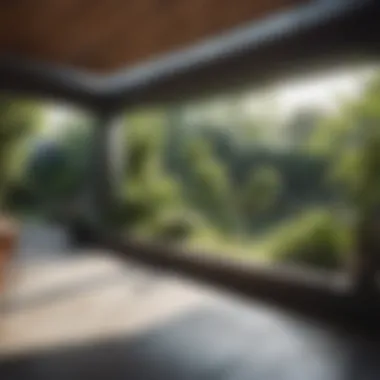Building Your Own Sustainable House: A Comprehensive Guide


Intro
Building a sustainable house is a significant endeavor that resonates deeply in today's world. With climate change impacting our daily lives, the focus on eco-friendly living has never been more pronounced. The concept goes beyond aesthetics; it involves thoughtful choices that impact not just our immediate surroundings, but the planet as a whole. In this guide, we will delve into the core components of constructing a sustainable home. This includes the careful selection of materials, design principles that promote efficiency, energy systems that leverage renewable resources, and practical maintenance strategies for longevity.
Understanding the relevance of sustainable living can be transformative. It not only fosters a healthier environment but also enriches your quality of life. By incorporating practices that reduce your carbon footprint and optimize resource consumption, you move towards an eco-friendly lifestyle.
As we explore each aspect, you'll find insights that cater to diverse homeowners and enthusiasts alike. This article aims at demystifying the complexities of sustainable home-building, presenting a clear path for anyone interested in creating a living space that harmonizes with nature.
Understanding Sustainable Housing
Understanding sustainable housing is crucial in today's context where environmental issues loom large. This concept extends beyond mere construction; it embodies a lifestyle choice. The aim is to create homes that reduce ecological footprints while improving the quality of life.
Sustainable housing emphasizes a holistic approach that integrates efficient energy use, water conservation, and materials selection. Every decision made during the planning and building phases influences the overall sustainability of the project. Without a clear grasp of what sustainable housing entails, homeowners might make choices that negate their intentions.
Defining Sustainability in Housing
Sustainability in housing refers to the ability to maintain ecological balance during construction and habitation. This encompasses the selection of materials, energy consumption, and waste management. The definition of sustainability in housing evolves as technology advances and as society's understanding of environmental impacts deepens.
Key factors that define sustainability in housing include:
- Energy efficiency: Utilizing technologies that minimize energy consumption while maximizing comfort.
- Water conservation: Implementing systems that reduce water waste, ensuring resources are preserved.
- Material choice: Selecting products that are renewable, recycled, or have a lower environmental impact.
- Design: Creating layouts that utilize natural light and airflow, thereby reducing reliance on artificial lighting and heating.
This multidimensional approach requires intentionality at each stage of the housing process.
Benefits of Sustainable Housing
Opting for sustainable housing presents numerous advantages that span environmental, economic, and social aspects.
- Environmental Impact: Sustainable homes significantly reduce carbon footprints. By minimizing energy and water usage, they help to combat climate change.
- Economic Benefits: Homes built with sustainable practices often see reduced utility bills. Energy-efficient homes can lead to long-term savings that outweigh initial costs, making them a smart investment.
- Healthier Living Spaces: Sustainable housing often prioritizes indoor air quality by using non-toxic materials. This contributes to a healthier environment for occupants.
- Community Resilience: Building sustainably promotes a sense of community and resource sharing, encouraging neighbors to engage in eco-friendly practices.
"Sustainable housing not only protects our environment but also enhances the quality of life for current and future generations."
Planning Your Sustainable Home
Planning your sustainable home is a critical step in the building process. It encompasses various aspects that could significantly influence your home’s overall efficiency and environmental impact. By taking the time to carefully plan your sustainable house, you can ensure that it meets your needs while contributing to a healthier planet. Key elements that must be considered during this stage include assessing your specific requirements, selecting an appropriate site, and understanding the zoning and permitting regulations that apply to your project.
Assessing Your Needs and Goals
Before any physical planning begins, you must evaluate your personal needs and distinct goals. This step provides clarity on what you want from your sustainable home. Consider factors such as family size, lifestyle preferences, and how much space is necessary. Think about your long-term objectives too, such as energy efficiency, reduced carbon footprint, and your connection with nature.
Identifying these needs requires honest self-reflection. Think about daily habits and future plans. This clarity guides your decisions, helping in the selection of materials and resources. For example, a family that enjoys gardening might prioritize outdoor spaces.
Collecting input from all family members can ensure everyone's needs are considered. Create a list of must-haves versus nice-to-haves. This approach aids in establishing priorities and also helps avoid costly mistakes down the line.
Site Selection and Orientation
The choice of site and its orientation are pivotal in sustainable house building. The location of your home will affect energy efficiency, solar access, and even water drainage. Evaluating the site requires understanding its natural topography, climate, and surrounding ecology.
When selecting your site, consider the availability of local resources and infrastructure. Access to public transport, local services, and community amenities can significantly enhance the livability of your new home. Additionally, think about potential environmental impacts on the site, such as soil erosion or habitat disruption.
Orientation plays a crucial role in harnessing natural light and regulating temperature. Positioning your home to maximize sunlight during winter while providing shade in summer can dramatically reduce energy costs associated with heating and cooling. A well-orientated home can take full advantage of passive solar heating and cooling techniques.
Zoning and Permitting Considerations
Navigating zoning laws and permits is often seen as a cumbersome task, yet it is an essential part of building your sustainable home. Zoning regulations determine how land can be used, including restrictions related to building height, lot coverage, and the types of structures permitted. Understanding these regulations can help avoid future legal complications.
Research the zoning laws pertinent to your chosen site. Early discussions with your local governing body can provide clarity on what is allowed. This is especially important if you plan to use unconventional building materials or techniques that may not fall within traditional definitions.
Permits are typically required for construction projects. Homeowners should be prepared to submit plans detailing their home’s design, materials, and intended use. Engaging an architect or builder familiar with sustainable practices can streamline this process.
Thorough planning in the early stages can save homeowners time and money in the long run while ensuring adherence to sustainable practices.
Choosing Sustainable Materials
Choosing sustainable materials is a foundational aspect of constructing an eco-friendly house. These materials not only reduce the environmental impact of construction but also enhance the overall health and comfort of the home. Sustainable materials can contribute to energy efficiency, lower utility costs, and a smaller carbon footprint. Understanding the choices available and the benefits they offer will guide homeowners in making informed decisions.
Identifying Eco-Friendly Materials
When selecting eco-friendly materials, it is important to consider both their source and their lifecycle. Materials like bamboo, reclaimed wood, and cork are excellent options. Bamboo grows quickly and can be harvested sustainably without causing harm to ecosystems. Reclaimed wood, often sourced from old barns or factories, gives new life to materials that would otherwise end up in landfills. Cork is another sustainable material that can be harvested without harming the tree, making it a unique choice for flooring and even insulation.
Homeowners should also look for products with certifications, such as the Forest Stewardship Council (FSC) label, which ensures that wood products come from sustainably managed forests. Using eco-friendly materials can often lead to a healthier indoor environment by reducing toxins and chemicals commonly found in traditional building materials.
Recycled and Upcycled Options
Recycled and upcycled materials are another important category to consider. These materials help in reducing waste by giving a second life to resources, thus requiring less energy in the production process. Items like recycled glass, metal, and plastics can be incorporated into various aspects of home construction.


For instance, recycled glass can be transformed into countertops or tiles, adding aesthetic value while being environmentally friendly. Upcycling involves creatively repurposing materials into new products. For example, old doors can be turned into tables, and reclaimed bricks can be used for patio construction. Consumers should actively search for local sources of upcycled materials to support the community and minimize transportation emissions.
Sustainable Insulation Choices
Insulation plays a critical role in energy conservation within a home. Sustainable insulation options provide better thermal performance and reduce energy consumption. Some effective eco-friendly insulation materials include cellulose, sheep's wool, and fiberglass made from recycled glass.
Cellulose insulation, made from recycled paper products, is one of the most environmentally friendly options available. It has excellent thermal performance and is treated with a fire retardant for safety. Sheep's wool insulation offers natural moisture regulation and thermal resistance, making it an effective option for energy savings. Moreover, fiberglass insulation made from recycled glass minimizes waste while providing substantial energy efficiency.
Overall, selecting sustainable materials involves careful consideration at each step. It addresses environmental concerns while promoting health and efficiency in the home. This commitment to sustainability allows for the construction of a dwelling that is not just livable but also conscious of its impact on the planet.
"Sustainable materials reflect a commitment to the environment and support energy efficiency, making sustainable housing not just a choice but a necessity for future living."
Each choice made in the materials selection process is an investment towards a greener future.
Design Principles for Sustainability
Design principles for sustainability are fundamental in the creation of eco-friendly homes. These principles guide the overall planning and execution of a sustainable building project. Employing effective design strategies can minimize energy consumption, reduce material waste, and enhance the overall livability of a home. When builders and homeowners incorporate sustainability in their designs, they address not only personal comfort but also broader environmental impacts. These principles are not merely guidelines; they are essential in fostering a healthier ecosystem.
Maximizing Natural Light
One effective way to enhance sustainability is by maximizing natural light. Natural light plays a crucial role in reducing the need for artificial lighting during the day. Proper placement of windows, skylights, and open spaces can significantly increase the amount of sunlight entering the home. This helps in lowering energy bills, as households rely less on electricity.
In addition, ample natural light contributes to the mental well-being of residents. Studies show that natural light improves mood and productivity. Architects can achieve this by designing spaces that promote daylight penetration. Orienting the house to take advantage of the sun’s path is a practical strategy for ensuring bright indoor spaces.
Efficient Layouts for Energy Efficiency
Creating efficient layouts is another key principle in sustainable home design. This involves organizing spaces in a manner that promotes energy conservation. An open floor plan can facilitate better airflow, reducing the reliance on heating and cooling systems. Smaller, well-placed rooms can minimize the energy required to maintain comfortable temperatures.
Furthermore, strategically locating areas that generate heat, like kitchens and living rooms, can enhance thermal efficiency. This will help keep other parts of the home cooler. Moreover, the use of thermal mass materials can store heat during the day and release it at night, contributing to overall energy efficiency.
"Design is a critical component in creating homes that not only serve their inhabitants but also the environment."
Adaptive Reuse Strategies
Adaptive reuse strategies represent another innovative approach in sustainable design. This practice involves repurposing existing structures instead of demolishing them. By adapting old buildings, homeowners can preserve historical value while reducing the demand for new construction materials.
This approach minimizes waste and preserves resources. Furthermore, adaptive reuse often requires less energy than ground-up construction. It allows for creativity in design, leading to unique living spaces. Owners can customize these buildings to meet modern needs while retaining the charm of the original structure. This not only benefits the individual but contributes positively to the community and its historical narrative.
Energy-Efficient Systems
Energy-efficient systems are integral for sustainable housing. They significantly reduce energy consumption and promote a more environmentally friendly lifestyle. Implementing these systems also results in long-term cost savings, aligning well with sustainable living goals. These systems often rely on renewable energy sources, which decrease dependence on fossil fuels. Moreover, energy-efficient systems contribute to a healthier indoor environment, enhancing comfort for residents.
Incorporating Renewable Energy Sources
Solar Power
Solar power is a leading renewable energy source in sustainable houses. It captures sunlight and converts it into electricity. A key characteristic of solar power is its ability to significantly lower electricity bills. Using solar panels reduces reliance on traditional utility companies. This is a popular choice among homeowners as it enables them to invest in energy independence.
One unique feature of solar power is its scalability. Homeowners can install a few panels or a whole system, depending on their energy needs. The advantages include low operational costs once installed, and potential tax incentives. However, initial installation costs can be high, making it a considerable investment.
Wind Energy
Wind energy harnesses the power of wind to generate electricity. This system involves the use of wind turbines. A vital characteristic of wind energy is its renewability. It significantly contributes to reducing carbon footprints in sustainable homes. Wind energy is especially beneficial in areas with consistent wind.
Wind turbines can be installed on-site. This offers homeowners a unique feature of home-based energy generation. Advantages include low running costs and minimal environmental impact. Disadvantages may involve noise and aesthetic concerns depending on the turbine's location.
Geothermal Heating
Geothermal heating utilizes the Earth's natural temperature to regulate indoor climate. It offers heating in winter and cooling in summer. This system is highly efficient, as it requires less energy compared to traditional heating and cooling systems. A significant characteristic of geothermal heating is its reliability and consistency; it works year-round.
Homes that employ geothermal systems feature a unique design involving buried pipes. The advantages include reduced energy costs and nearly zero emissions. However, the initial cost of installation can be high, which is an important consideration for homeowners.
Advanced Heating and Cooling Technologies
Advanced heating and cooling technologies enhance energy efficiency and comfort in homes. These systems are designed to use less energy while still providing effective temperature control. By incorporating these technologies, homeowners can achieve a more sustainable living environment, thus aligning with eco-friendly lifestyle choices.
Heat Pumps
Heat pumps operate by transferring heat rather than generating it. They can provide both heating and cooling, making them versatile. A key characteristic of heat pumps is their energy efficiency. They often consume less electric power compared to traditional heating units. This makes heat pumps a beneficial choice for households aiming to lower their energy bills.
The unique feature of heat pumps is their ability to work in various climates. This adaptability is an advantage for many homeowners. However, upfront costs can be a barrier to some, but long-term savings often offset this.
Radiant Floor Heating
Radiant floor heating involves warming the floors of a home to heat the space. It heats a room evenly from the ground up. One characteristic of radiant floor heating is its comfort level. It offers a more even heat distribution compared to traditional methods.


A unique feature of radiant heating is its efficient operation. It can be powered by various energy sources, including solar systems. Advantages include energy savings and increased comfort. Disadvantages may include higher installation costs and challenges in retrofitting existing structures.
Effective energy-efficient systems rely on an understanding of both technology and the specific needs of the home environment.
Water Conservation Techniques
Water conservation is a critical aspect of sustainable living. With growing concerns over water scarcity and environmental degradation, it is essential to integrate water conservation techniques into the design and construction of a sustainable house. Implementing these methods not only reduces water consumption but also promotes a healthy ecosystem. Homeowners can significantly decrease their water footprint, thus contributing to a more viable future for subsequent generations.
Rainwater Harvesting Systems
Rainwater harvesting systems capture and store rainwater for various uses in the household. This technique reduces reliance on municipal water supply, easing pressure on local resources. The collected rainwater can be utilized for irrigation, flushing toilets, and even in certain domestic applications when properly filtered.
Key benefits of rainwater harvesting include:
- Cost Savings: Reducing dependence on public water systems can lower water bills.
- Sustainability: Utilizing a natural resource conserves potable water.
- Erosion Control: Collected rainwater can be used in gardens, limiting runoff and soil erosion.
When designing a rainwater harvesting system, several elements should be considered:
- Collection Surface: Roofs are commonly used. However, material choice impacts water quality.
- Storage Tanks: Adequate sizing based on average rainfall is necessary for effective management.
- Filtration Systems: To ensure the water is safe for use, appropriate filtration must be in place.
"Effective water management through rainwater harvesting provides both savings and environmental benefits."
Greywater Recycling Methods
Greywater recycling involves reclaiming wastewater from sources like showers, sinks, and washing machines for reuse. This process can significantly cut down on the amount of water consumed in a household. Unlike blackwater, which contains pathogens from toilets, greywater can be safely reused for irrigation and flushing toilets.
Benefits of greywater recycling include:
- Reduced Water Bills: By reusing water, homeowners can save costs significantly.
- Lower Impact on Sewage Systems: Reducing the volume of waste entering sewage treatment facilities eases the burden on municipal systems.
- Promotes Plant Growth: The nutrients in greywater can benefit garden plants when used appropriately.
When implementing greywater recycling, consider:
- System Design: Proper installation and choice of a system are essential to prevent contamination.
- Types of Greywater: Understanding which sources are suitable for recycling helps to maximize benefits. For example, water from baths and kitchens often contain higher levels of contaminants.
- Local Regulations: Ensure compliance with local laws concerning greywater use.
By adopting rainwater harvesting systems and greywater recycling methods, homeowners can take significant steps toward more sustainable living. Both techniques offer practical solutions to conserving water and contribute positively to environmental sustainability.
Landscape Integration for Sustainability
Landscape integration is a crucial aspect of building a sustainable house. It goes beyond aesthetics; it creates a symbiotic relationship between the structure and its surrounding environment. This approach contributes to ecological balance, reduces resource consumption, and enhances quality of life. Careful consideration of landscaping can improve energy efficiency and prioritizes biodiversity.
Incorporating sustainable landscaping practices benefits homeowners in various ways. First, it often leads to reduced maintenance costs over time. Native plants, for example, require less water and fertilizer, making them more cost-effective solutions. Second, well-designed landscapes can help manage stormwater runoff, resulting in less erosion and improved water quality.
When discussing landscape integration, it is essential to consider factors such as the local climate, soil type, and existing wildlife. These elements will influence not only the types of plants chosen but also how they fit into the overall ecosystem. Moreover, by increasing the number of native plant species in a landscape, homeowners can support local wildlife populations, specifically birds and beneficial insects.
"Incorporating native plants supports local ecosystems and reduces the need for chemical fertilizers or pesticides."
Additionally, sustainability in landscaping involves the use of permeable materials for driveways and walkways. This reduces surface runoff while allowing water to filter back into the ground. These practices not only support environmental efforts but also improve the aesthetic quality of the home environment.
Overall, integrating landscape sustainability into your home-building process adds significant value. It creates a more harmonious living environment and extends the benefits of sustainability beyond the house itself.
Native Plant Selection
Choosing native plants is vital for creating a sustainable landscape. Native plants are those that naturally grow in a specific region. They are adapted to local conditions, making them easier to maintain. This selection process can also enhance local biodiversity. Native plants provide habitat and food for various species, including birds, insects, and other wildlife.
When selecting native plants, consider the local climate, soil characteristics, and existing vegetation. Conduct research to determine which species are native to your area and how they can complement each other visually and ecologically. Engaging with a local nursery that specializes in native species may provide valuable insights.
Permaculture Practices
Permaculture represents a holistic approach to landscaping and sustainable living. It employs principles of ecology and social responsibility to design land that can sustainably produce food while incorporating natural ecosystems. This methodology emphasizes the harmonious interrelationship between humans and nature.
Implementing permaculture practices can significantly improve the sustainability of your landscape. For example, creating swales or contour gardens helps slow water runoff, promoting infiltration and reducing erosion. Additionally, integrating fruit trees, vegetable gardens, and herbs fosters a multi-functional landscape that supports both food production and ecological health.
Principles of permaculture also advocate for closed-loop systems. This means using waste from one part of the system to support another. For instance, composting kitchen scraps can provide nutrient-rich soil for garden beds, creating resilience in the home ecosystem.
Incorporating both native plant selection and permaculture practices lays the foundation for a sustainable landscape. They not only enhance the beauty of the property but also establish ecosystems that contribute positively to environmental health.
Construction Techniques for Sustainable Homes
The role of construction techniques in building sustainable homes is paramount. Sustainable construction goes beyond simple building methods. It involves considering the impact of the construction process on the environment, the efficiency of the materials used, and the longevity of the home. Key practices in this area not only save resources but also enhance the house's resilience against climate challenges. Taking the time to understand these techniques leads to significant benefits. They can reduce the carbon footprint, save water, and minimize overall energy consumption.
Eco-Friendly Construction Practices
Eco-friendly construction practices are essential in the creation of sustainable homes. This approach emphasizes using renewable resources, energy-efficient materials, and innovative building methods. One major aspect is the integration of local materials. Alternatives such as bamboo or salvaged wood can minimize transportation emissions. Using low-impact concrete also plays a critical role. This type of concrete reduces energy usage during its production.
Moreover, proper insulation technique is also vital. Superior insulation maintains temperature effectively, thus reducing the need for heating or cooling. Another important practice is utilizing modular construction. It enables more precise cuts and reduces material waste.


Minimizing Waste During Construction
Minimizing waste during construction is a crucial element for sustainable homes. The building process often generates significant amounts of debris. To counteract this waste, planning becomes crucial. Evaluate the materials needed upfront. Any excess can lead to increased disposal. Using prefabricated building elements is one method to lower waste. These parts can be manufactured off-site with precision, which leads to less leftover material.
Additionally, adopting a waste management plan can greatly help. This plan should include recycling practices for materials such as metal, wood, and concrete. It is also beneficial to encourage the use of biodegradable materials when possible.
"Sustainable construction is not just a trend; it is a responsibility towards future generations."
By employing these eco-friendly techniques, homeowners can ensure that their living spaces meet modern environmental standards while still being cost-effective. Ultimately, these construction practices lead to a more sustainable future.
Costs and Financial Incentives
Understanding the costs and financial incentives of building a sustainable house is vital for potential homeowners. These factors not only impact the initial investment but also affect long-term sustainability and living costs. As the trend towards eco-friendly living increases, so do the number of available financial options to support sustainable construction. Knowing how to navigate these costs and incentives can lead to a more sustainable and economically viable project.
Budgeting for a Sustainable Home
Creating a budget for a sustainable home involves careful planning and consideration. Sustainable housing often requires upfront investment, but this should be viewed as a long-term savings strategy. Start with a detailed breakdown of all expected costs, including materials, labor, permits, and post-construction needs such as landscaping and energy systems.
When budgeting, consider the following:
- Initial Costs: These may include higher costs for eco-friendly materials and specialized construction methods.
- Long-Term Savings: Energy-efficient systems may cost more initially but can lead to significant savings on utility bills.
- Maintenance Costs: Sustainable homes often require different maintenance considerations. It’s important to factor these in.
Engaging a financial planner can also be beneficial. They can help identify areas where you might save or where additional investment can lead to better returns.
Government Incentives and Grants
Financial support from the government is another crucial component in the realm of building sustainable homes. Various incentives and grants exist, encouraging homeowners to adopt green building practices. These incentives can significantly offset construction costs and encourage eco-friendly innovations. Popular options include:
- Tax Credits: Homeowners may qualify for tax reductions based on the use of renewable energy systems or sustainable materials.
- Grants: Certain programs offer financial assistance with specific sustainable projects, aiding in installations like solar panels or energy-efficient windows.
- Low-Interest Loans: Some banks and governmental bodies offer loans with reduced interest rates for those committing to sustainable housing.
"Investing in sustainable homes can yield not just environmental benefits but also long-term financial rewards through various incentives and reduced operational costs."
To find available incentives, consult local government websites or organizations like the U.S. Department of Energy. They often provide updated information on grants and programs that can aid in your project.
Long-Term Sustainability Practices
Long-term sustainability practices are essential for ensuring that a home continues to meet the goals of energy efficiency, environmental responsibility, and resource conservation over its lifespan. Effective long-term planning includes considerations such as proper maintenance, adaptive strategies, and community involvement. These practices not only help homeowners sustain their investment but also contribute to the broader goal of promoting environmentally friendly living within a community.
Maintenance of Sustainable Systems
In any sustainable home, regular maintenance of systems is crucial. Keeping systems such as solar panels, rainwater harvesting, and greywater recycling in good condition ensures optimal performance. For example, solar panels require periodic cleaning to remove dust and debris, which can hinder energy absorption. Similarly, rainwater systems must be checked for blockages or leaks to maintain functionality.
The maintenance schedule for these systems should be a part of the overall home care plan. Homeowners may want to consider the following:
- Set reminders for regular inspections of energy systems.
- Keep manuals and contact information for service professionals readily available.
- Document maintenance tasks for future reference.
Implementing these practices can lead to lower utility bills and increased longevity of the systems.
Continuous Improvement Strategies
Continuous improvement strategies refer to the ongoing process of evaluating and enhancing sustainability practices. Homeowners can regularly assess their resource use and look for areas of improvement. This might involve switching to energy-efficient appliances, upgrading insulation, or incorporating smart home technology that optimizes energy use. Environmentally-conscious individuals can follow these strategies to drive improvements:
- Track energy and water usage to identify patterns and areas to cut back.
- Research the latest sustainable technologies and practices.
- Engage with local sustainability initiatives for support and new ideas.
Leveraging these strategies not only enhances home performance but also aligns with broader environmental goals, ultimately contributing to a healthier planet.
"Sustainability is not a destination but a journey; a commitment to perpetual improvement is vital for success."
Long-term sustainability practices are the foundation for creating a truly eco-friendly home. They promote efficiency and conservation that lasts through generations, ensuring that the commitment to sustainability becomes an integral part of daily life.
Community Integration and Sustainable Living
Building a sustainable house extends beyond the architectural and material choices made during construction. It involves creating a sense of community that prioritizes ecological consciousness and collaborative living. Community integration significantly enriches the sustainable living experience, offering a framework where individuals and families can thrive while being mindful of their environmental impact. By participating in cohesive communities, homeowners can share resources, knowledge, and mutual support, thus enhancing their overall quality of life.
Participating in Eco-Friendly Communities
Engaging with eco-friendly communities is a cornerstone of sustainable living. These communities often promote values aligned with sustainability, encouraging practices that focus on preserving the natural environment.
Benefits include:
- Shared Resources: Access to tools, gardens, or workshops helps reduce personal expenses and overall waste.
- Collective Learning: Learning opportunities arise from workshops or events centered on sustainability, making knowledge transfer smooth and effective.
- Networking and Support: Building relationships can foster partnerships for community projects like local clean-ups or green space creations.
When homeowners actively participate in these networks, they cultivate a sense of belonging, leading to increased responsibility toward environmental stewardship.
Promoting Sustainable Practices Locally
Local advocacy for sustainable practices is essential for effecting change on a broader scale. Homeowners can contribute by:
- Organizing Local Events: Activities like community gardens or recycling drives can encourage more individuals to adopt sustainable habits.
- Collaborating with Local Businesses: By supporting local enterprises that prioritize eco-friendly practices, homeowners help to create a more sustainable economy.
- Raising Awareness: Sharing information about sustainable systems and practices through workshops or social media can educate others about the invaluable benefits of sustainability.
"The future of our planet largely depends on our ability to work together toward sustainable practices at the community level."







